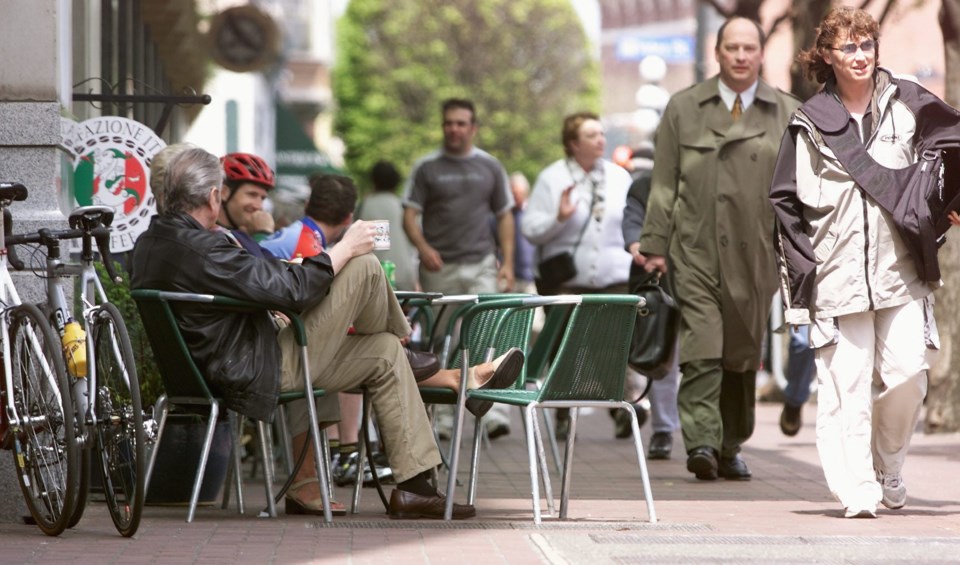According to Statistics Canada’s 2016 data, 17,600 Victoria-area residents walk to work regularly.
That is, just over 10 per cent of all of the region’s commuters prefer to hoof it daily instead of driving solo (61.2 per cent), carpooling (11 per cent), busing (10.9 per cent) or cycling (6.6 per cent). I just want to point out that walking to work in Victoria is almost as popular as either carpooling or busing.
No other city in Canada has so high a proportion of walking commuters. Halifax follows next in line with 16,000 pedestrian commuters (8.2 per cent), and Kingston has 5,500 (7.6 per cent).
Our climate means that sidewalks and pathways are rarely slippery.
But Vancouver enjoys a similarly mild — albeit rainier — climate. Although its absolute numbers of walking-to-workers (77,700 of 1,159,000 commuters) are higher than Victoria’s, the percentage of those walking to work is lower (6.7).
Our region’s compact and relatively flat geography means it’s possible to march downtown from Tillicum, Oak Bay, Vic West or Esquimalt in a reasonable amount of time and with a minimal amount of sweat. Pathways that funnel pedestrians and cyclists toward the region’s core business area — for example, the Galloping Goose and Gorge Waterway trails, Westsong walkway and the Harbour pathway — also help to entice people to lope along outside to work every day.
However, what does not encourage commuting on foot in the region are the lack of sidewalks in many neighbourhoods and the poor condition of many sidewalks that do exist.
This year, Walk On, Victoria, Greater Victoria’s pedestrian advocacy group, asked residents what they thought was most needed to make Greater Victoria more walkable. The top four responses called for policies that encourage mixed-used, walkable neighbourhoods, better-maintained sidewalks, more marked crosswalks and reduced speed limits. More sidewalks, wider sidewalks and better lighting were other popular responses.
Sidewalks were a consistent, repeated theme.
Some readers have pointed out to me that municipalities and businesses use many of the region’s sidewalks for many things other than providing space for pedestrians to travel safely along roadsides. Sidewalks are routinely co-opted as spaces to put utility poles, electrical boxes, benches, bus stops, signs and even restaurant patios. In addition, untrimmed hedges and trees encroach on sidewalk spaces, and broken, heaved and uneven pavement further restricts pedestrian movement.
All of that bottlenecks foot-traffic flow and increases the risk of tripping and collisions.
What might be reasonably workable with a few fit and nimble pedestrians becomes treacherous once a steady stream of people starts passing up and down the street — all moving at different speeds. Walking suddenly becomes less about striding forward than dodging sideways — to avoid bus shelters, garbage bins, bike racks, sandwich boards, doors propped open, trees, slippery ventilation grates, tripping hazards, people standing waiting for the bus, that person using the walker or cane, and so on.
Fancy footwork, indeed.
Walking is a highly energy-efficient form of movement with many social and health benefits, but walking through sidewalk clutter slows the pace, adds time to the commute and decreases the efficiency.
In addition to creating physical barriers, clutter serves as a psychological deterrent to walking. It signals:
• That cycling and transit take precedence over walking in municipal planning and thinking.
• That roadside restaurants and businesses have more rights to pedestrians’ traditional spaces than pedestrians have.
• That maintenance of pedestrian thoroughfares is deemed a lesser priority.
• That all those other uses of the sidewalk are valued more than pedestrian safety and comfort.
In short, that pedestrians just aren’t all that important.
Bus stops, bike racks, garbage cans, light posts and benches are important in a city and need their own spaces along our thoroughfares. But those spaces shouldn’t come at the expense of pedestrian flow and safety. If sidewalks are being recast as receptacles for these various elements of a city’s streetscape, that just shows a lack of foresight on the part of past planners and a skewed set of priorities for today’s planners.
Perhaps the first step to converting all those pedestrian concerns to action is to insist that those who make the decisions about what lines our streetscapes in high-foot-traffic areas should commute through those areas — on foot, of course.



